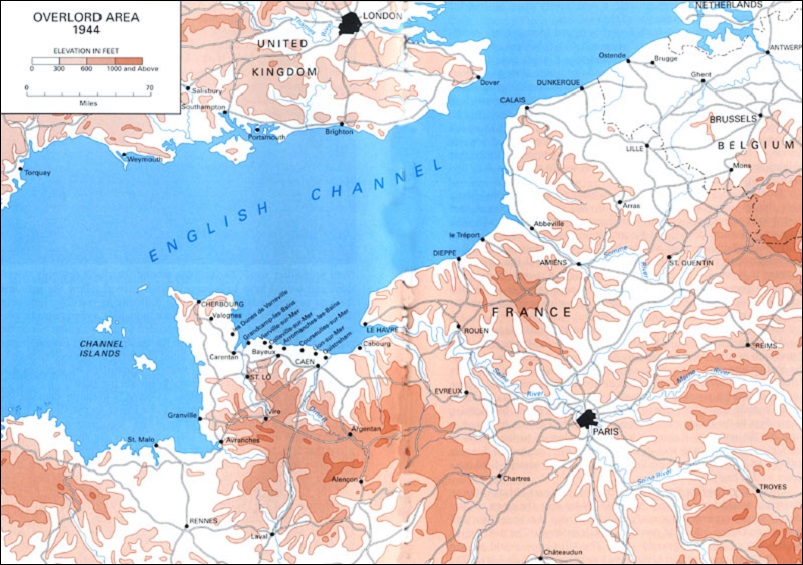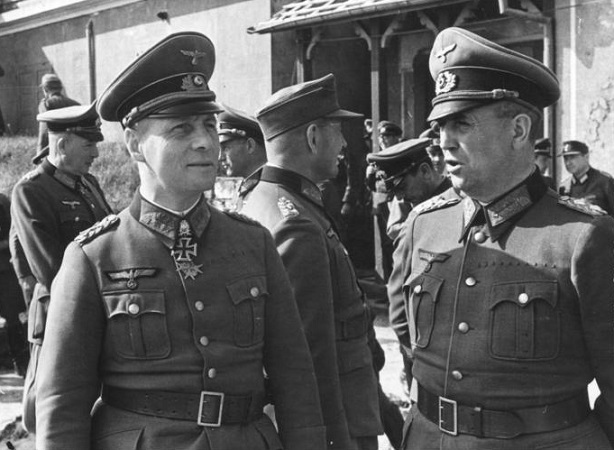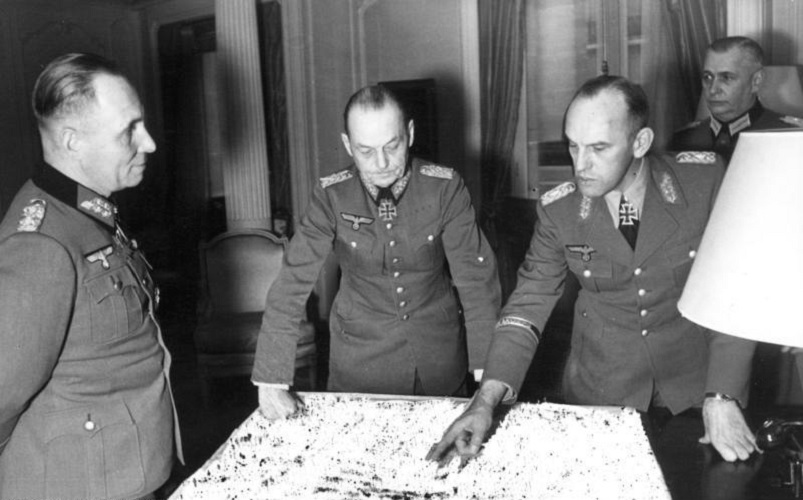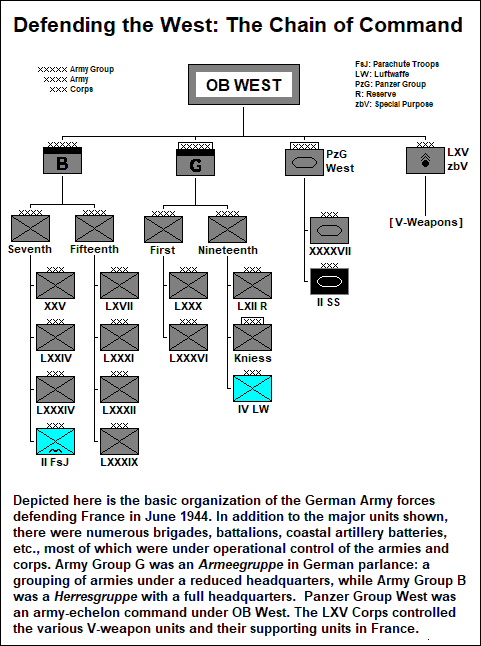The German forces tasked to
repulse the long-expected Allied invasion of France were
under the command of the Oberbefehlshaber
West
(Commander-in-Chief West)—OB
West for short—which also referred to the headquarters as a
whole. Since March 1942
this command had been held by Field Marshal Gerd von
Rundstedt, the Army’s senior officer,
who
in June 1944 was sixty-nine years old. OB West
had two major formations:
Armeegruppe
G
(Colonel-General
Johannes Blaskowitz), responsible for the defense of the
Atlantic and Mediterranean coasts of France; and
Heeresgruppe
B (Field Marshal Erwin Rommel),
responsible for the defense of Brittany and the Channel
coast of France and Belgium. An additional headquarters,
Panzergruppe West
(later to become
5. Panzerarmee), controlled three
of the six panzer divisions in the
HG B zone.
OB West was answerable to the High Command of the Armed
Forces: Oberkommando der Wehrmacht
or OKW. In
his capacity as supreme commander of the armed forces Hitler
issued his orders through OKW, which also served as his
planning staff. (The High Command of the Army,
Oberkommando des Heeres
or OKH, was by now restricted to the conduct of operations
on the Eastern Front on Hitler’s behalf in his capacity as
commander-in-chief of the Army.)
If this
chain of command seems straightforward, the reality was
otherwise. As Rundstedt complained, his authority was
circumscribed by Hitler, who was not hesitant to issue
orders over the head of OB West. Moreover, neither Rundstedt
nor Rommel had full control of the six panzer divisions in
the
HG B
zone. The three under
Panzergruppe West
were designated as OKW reserves—meaning that they could not
be committed to action without Hitler’s express
authorization. This was to have fateful consequences on the
day of the invasion.

Normandy and northwestern
France (Department of History, USMA West Point)
Since it
was considered certain that the invasion, when it came,
would strike somewhere between Brittany and Calais,
two-thirds of the forces at the disposal of OB West were
allotted to
HG B. The question was precisely where
in this area the Allies would land. The obvious spot was the
Pas de Calais, where the English Channel was at its
narrowest. But there were reasons to think that the enemy
might choose Normandy instead. The early seizure of a major
port was an obvious Allied objective and Cherbourg at the
tip of the Normandy peninsula fitted the bill. And this
indeed was a major consideration in the Allies’ choice of
Normandy. Hitler himself, though he agreed with his generals
that the Pas de Calais was the Allies' most likely target,
could not rid himself of the suspicion that they might
strike in Normandy instead—one more example of the intuition
that the Führer sometimes
displayed during the war.
Two
additional factors complicated this guessing game. First,
there was Hitler’s anxiety concerning Norway, where he
suspected that the Allies might attempt a landing with the
objective of barring Germany’s access to Swedish iron
ore—essential to industrial production. Second, there was
Operation Fortitude, an Allied deception plan designed to
convince the Germans that the invasion would come at the Pas
de Calais. This involved the creation of a phantom army
group in England, supposedly under the command of Lieutenant
General George S. Patton. Fake radio traffic, dummy tanks
and guns made of wood and canvas and other deceptions were
highly successful in convincing German commanders that Pas
De Calais was the Allied target. Even on and after 6 June
1944, Rundstedt and others suspected that the Normandy
landing was merely a diversion, and that the real invasion
had yet to be launched.
Nor was
there unanimity of opinion regarding operational and
tactical matters. Rommel, whose task it would be to conduct
the defensive battle, believed that it was vital to
concentrate all reserves close to the coast, in readiness to
meet the invasion on the beaches and throw it back into the
sea. If the Allies were not promptly repulsed, he argued,
they were unlikely to be driven out at all. Rommel’s
experiences during the campaign in North Africa had
convinced him that thanks to Allied air superiority,
reserves positioned inland would be unable to reach the
coast in time to prevent the enemy from consolidating a
bridgehead.

Rommel (left) on
an inspection tour of the Channel coast defenses (World War
Photos)
But his
superior Rundstedt and many others on the OB West staff
disagreed. Basing themselves on traditional military
principles of concentration and mass, they advocated the
creation of a powerful panzer reserve, positioned well
inland, to deliver a well-planned, carefully prepared
counterattack, smashing the invaders in their beachheads
before they could build up their strength. The preparation
and conduct of this counterattack was to be the mission of
Panzergruppe West; in the meantime the German infantry
divisions, withdrawn out of range of naval gunfire, would
dig in and cordon off the invasion zone.
Both
sides appealed to Hitler—who characteristically split the
difference. Three of the six immediately available panzer
divisions were placed under
HG B. The other three
remained with
Panzergruppe West and were not to be committed
to action without OKW approval. In effect, the Führer’s
decision approved Rommel’s plan without giving him the
forces necessary to do the job. The beaches were sown with
mines, strewn with obstacles and covered by artillery.
Protected fighting positions for the defending infantry were
constructed with interlocking fields of fire. But the
reserves—the panzer divisions especially—were not positioned
as Rommel desired. On D-Day only one of them, the
21.
Panzer-Division, was immediately available to launch a
counterattack—which failed. And just as the Desert Fox had
predicted, the enemy was able to consolidate a bridgehead
from which he could not be dislodged.
Whether
Rommel or Rundstedt was right in this dispute over
operations and tactics is a doubtful question, though with
hindsight it appears that Rommel’s assessment of the
situation was more realistic. In view of the Allies’ overall
superiority of forces it seems unlikely, albeit it not quite
impossible, that the Germans could have repulsed the
invasion. But there can be no doubt that Hitler’s failure to
make a clear-cut decision was prominent among those factors
contributing toward the German Army’s catastrophic defeat in
the Battle of Normandy.
● ● ●




